Aziel is an inhabited planet of Nilus' Auralumina System, and a former member of the United Terran Federation. Aziel saw its unexpected departure from the nation two hundred years ago through a spatial anomaly which transported it to uncivilized space in the other side of the galaxy. Aziel and its moons were deemed to succumb to mass hysteria, an event which fortunately didn't happen for most major settlements. Aziel's infrastructure would collapse shortly thereafter, leaving the planet in utter chaos and destruction. Amidst the unending chaos, the first country, Nachor's Federation, was founded after the collaboration of several loose alliances. Soon afterward, Aziel's environment would soon grow into a more peaceful state, and many began to rebuild human civilization. In the modern days, Aziel is a lush and prospering world governed by several great countries and confederations, united in global peace for only one goal: to reclaim their place in the United *Terran Federation. Inbetween these huge countries lie smaller, less developed countries that are frequently at odds over natural resources such as water and food. Multiple nations have progressed far beyond Aziel to become independent interplanetary nations, gaining sovereignty of several of the Auralumina System's worlds.
Aziel was initially settled two thousand years before the Auralumina System's frontiers were engulfed in gravitational anomalies. Aziel was one of the first interstellar worlds inhabited by the UTF since as was a perfectly habitable world for humans in terms of gravity, temperature, and atmosphere. Several interstellar probes were dispatched to it at first to confirm its habitability. Several colony ships arrived shortly afterward, carrying thousands in search of a new home. The colony ships were dismantled and shaped into several settlements scattered over the planet in dramatically different settings upon planetfall on Aziel. Ryker's Landing was the largest of them, housing more than fifty thousand people under its protection. Rkyer's Landing would have a brief lifespan, as it was quickly discovered that it was built directly over an underground passage that led straight to Hollow Aziel. The fifty thousand inhabitants were evenly distributed among the other colonies to assure their safety. More residential complexes required to be built to accommodate the influx of new inhabitants. The colonies would soon develop into large and distinct urban centers as a result of these expansions.
Aziel is a rich world teeming with life in every crevice, from the harshest wastelands to the deepest seas. As one might anticipate from life on a planet like Aziel, the organisms that inhabit there are carbon-based and utilize water as a solvent. Microbial creatures were the first to appear, feasting on the material emitted by hydrothermal vents on the seafloor. Subsequently, fish and invertebrates began to populate the waters. Aziel's seas were teeming with life of all types in under a hundred million years. Shortly thereafter, aquatic vegetation arose as a result of the evolution of algae. The residents of Aziel, like any other form of life, began to seek out new horizons to conquer. Organisms gradually began to populate the lands, developing to cope with the new and odd terrestrial environment. The planet would be teeming with life until a catastrophic annihilation event occurred in the form of an asteroid impact. Most life was exterminated, yet a few species proceeded to thrive in the apocalyptic wasteland that Aziel had become. After Aziel was spontaneously cleansed of adverse conditions, the amount of life began to rapidly elevate.
Aziel has been the birthplace of three intelligent species, and many more that have remained undiscovered to this day. All of these intelligent species were able to engulf the planet in vast civilizations, one of which had also reached Cadonia. But as time progressed, each of these vast civilizations eventually destroyed themselves from the inside, leaving only loose clans of dedicated survivors, which over time fell into the hands of death as well. The destruction the civilizations laid waste across the planet still remains, as numerous craters of destruction dot the surface of Aziel, along with the ruins of once-thriving cities, now dead and overgrown with nature's growing dominance. These ruins are one of the more prominent tourist attractions in Aziel in the present day, inviting millions of civilians to explore. All of these species existed more than a billion years ago. As in the current eras, no alien civilizations have taken hold of the domains of Aziel yet.
Aziel is surrounded by three spherical and two asteroid moons. Since Aziel was isolated from the rest of the UTF, these moons have been a main focus of colonization. Cadonia is the first of the three spherical moons. At first, Cadonia was a dead and airless moon, but it was thoroughly terraformed soon after Aziel was inhabited. Cadonia today is a lush and tropical world teeming with lifeforms descended from Aziel, the most populated moon in the Aziel system. Altum, the second of these moons, is a hospitable but frigid icy wasteland engulfed in a global layer of ice. Altum's terrestrial zones and subglacial waters are both home to several distinct ecosystems of life. Voyager is the third spherical moon of Aziel, and is more of a megastructure than a cosmic body. A massive array of boundless exotic technology resides on Voyager, which is restricted by a safe-lock mechanism. When Aziel was cut off from the rest of the UTF, the settlements on these moons experienced widespread panic and desertion. As they were unable to be entirely self-sufficient and had to rely on exports from other worlds, the majority of the population of these moons died as a result of conflict, starvation, or dehydration. These moons are presently covered with countless abandoned settlements, and the nations of Aziel have only recently begun to repopulate them. The two asteroid moons, Erazium and Krylium, are largely used for extracting resources for the Auralumina System's worlds. These two moons are expected to be entirely mined during the next ten millennia.
Deep below the ground, near the core, is a vast subterranean environment known as the Hollow Aziel. Hollow Aziel is frequently interpreted as a gigantic cavern encircling the core several thousand kilometers from Aziel's absolute center, although this is not the case. Hollow Aziel is an interconnected network of several unimaginably enormous caverns near the core, each spanning at least a hundred kilometers in both length and height. Hollow Aziel is fully illuminated by Solar Bulbs, which are extraordinarily luminous organisms which attach themselves to the ceiling and emit massive amounts of light. As a result, the terrain of Hollow Aziel can as bright as it is on the surface. More bizarrely, solar bulbs precisely mirror Aziel's day-night cycle, albeit it is unknown how they do so. Hollow Aziel's geography is largely flat, with a few mountains, canyons, and jagged areas thrown in between Most significantly, Hollow Aziel is teeming with all manner of exotic wildlife and vegetation. These organisms have grown to titanic proportions, considerably larger than any lifeforms on Aziel's surface, mostly by feeding on the radiation generated by the core. Nonetheless, regular diets are still typical in several animal species across Hollow Aziel. In certain areas, Hollow Aziel is so identical to the surface of Aziel that it can be nearly impossible to determine whether one is on Aziel or in Hollow Aziel, without knowledge if one is on one or the other.
Surprisingly, Aziel did not form within the confines of the Auralumina System. Rather, it formed in a different system which is now located approximately ten light-years from Auralumina. This system, named Kalina's System, has a blue main-sequence star as it's central star, which is orbited by two gas giants and one terrestrial planet, none of which have any semblance of life on them. Aziel was initially kicked out of its system as the planets were battling for gravitational dominance. In the following months a depressing fate met Aziel, as its parent star got smaller and smaller until it became one of the innumerable stars in the celestial sky. After millions of years of hibernation in the cold dark interstellar space, Aziel managed to be caught in the Auralumina System, in which it would remain for the remainder of it's existence. Aziel's cosmic journey saw its end when it finally got into a stable orbit in the goldilocks zone of the Auralumina System.
Properties[]
Physical Properties[]
Atmospheric Properties[]
Aziel's atmosphere is composed of hundreds of individual gasses, yet only a few have a significant impact on the planet on a broader scale, if any at all. Four gases make up the majority of Aziel's atmosphere: nitrogen, oxygen, argon, and carbon dioxide. Aziel's atmosphere also has a varying amount of water vapor, with an average of roughly 0.9 percent at sea level and 0.3 percent throughout the air. Aziel's atmosphere and it's pressure are ideal for humans, which was a major factor in the settlement of the planet. At sea level, the average atmospheric pressure is defined as 1.054 atmospheres.
The atmosphere of Aziel preserves life on the planet by providing pressure on the surface that allows liquid water to persist, absorbing solar radiation, warming the surface through heat retention, and decreasing temperature variations between day and night. As a result, Aziel's atmosphere is without a doubt one of its most significant characteristics, as it would be nothing like it is presently if it weren't for it.
The gasses in the Auralumina's solar nebula, predominantly hydrogen, made up Aziel's early atmosphere. Many variables such as volcanism, life, and weathering influenced the atmosphere's evolution over time. The oxygen count was more than twice what it is currently a billion years ago, allowing considerably larger lifeforms to flourish. When Aziel collided with a cloud of nitrogen in space around that same time, the composition and pressure of its atmosphere were altered to be roughly equal to that of today.
Orbital Properties[]
Climate[]
Aziel has one of the most diverse climates in the entire Auralumina System. It's climate is varied depending on each hemisphere, with areas warm enough to creating boiling deserts, while others are cold enough to create mazes of icebergs. Temperatures also range from being cold enough at the poles to freeze water and warm enough at the equator to fry an egg on a metallic surface. Each region of Aziel has a unique biosphere able to support a variety of plant and animal life.
This climate is also kept in check by the planet's inhabitants, using artificial climate generators in order to keep a desired temperature and climate in the various regions of the planet. These climate generators have also allowed Aziel to become more habitable to life then it was originally.
Moon System[]
Cadonia[]
Altum[]
Voyager[]
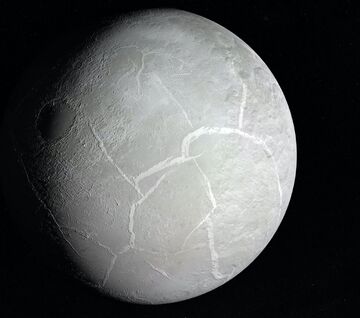
Voyager, a dull celestial body which holds extensive knowledge of reality and unfathomable exotic technology
The most fascinating of Aziel's moons is Voyager, also known as the Spaceship Moon, which is more like an alien megastructure than a celestial body. Voyager has only been in the Auralumina System for a year, and does not even orbit Aziel. Instead, it's in the borders of Aziel's hill sphere, although it orbits Auralumina, which is one of Voyager's odder characteristics. Furthermore, Voyager seems to be a prosaic, airless celestial body, yet it conceals unfathomable technology that is waiting to be uncovered deep within. Voyager to be deserted due to an onboard emergency, as evidenced by the lack of occupants and the state of disrepair. Many people wonder what caused this devastation on a regular basis, despite the fact that no possible scenarios have been proven yet
The greatest riddle surrounding Voyager is how it accessed the Auralumina System in such a massive flash, despite the fact that nothing had been supposed to be capable of passing through the gravitational anomalies at the system's frontiers. This occurrence demonstrates that it is feasible to break free from the system, prompting many of Aziel's research organizations to band together to understand more about how to do so. If mankind were to actually escape the Auralumina System's grasp, it would once again demonstrate that humans can adjust and prosper even under the strangest of circumstances.
An immense complex of control rooms, living quarters, and places with unknown purposes resides within Voyager. When fully accessed, the technology aboard Voyager might provide mankind with limitless knowledge of the Cosmos and the structure of reality. This insight alone has the ability to accelerate humanity's technological advancement to Type-3 status in a few of decades. The manipulation of space-time, natural laws, and even the Cosmos has already been demonstrated by Voyager. Unfortunately, the technology deep within Voyager can't be used in a practical fashion, as it's protected by a safe-lock mechanism. Though there has been some progress, it is still decades or possibly centuries away from being completely bypassed, depending on how quickly technology advances for humans.
Geography[]
Hollow Aziel[]
Countries[]
Aziel is home to twenty-seven large countries, the bulk of which are planetary, though several of them have colonized several worlds. Nachor's Federation is the largest country on Aziel, encompassing the entirety of Equis as well as other archipelagos and islands surrounding it, most notably the Eyus Island. However, Astiyunia is the most populous, with a population of five billion people, accounting for about a quarter of the total population on the planet. Astiyunia is also the most powerful nation, with trade relations to nearly every country on the planet. Democracy, whether presidential or parliamentary, is the most common type of governance on Aziel, with eighteen countries governed in this fashion. Monarchy is also a common type of administration on Aziel, as there are presently eight kings and queens in power. Dictatorships existed in the past, when Aziel was less sophisticated and more anarchic, but these countries have since been abolished, and millions of civilians have been liberated from the clutches of several cruel dictators.
Several countries have formed alliances and confederacies, the most notable of which is the Agran Concord, which unites 10 unique and distinct countries on the world in peace, trade, and cooperation among their citizens. Several minor alliances have formed as well, though their number has steadily dropped since the Agran Concord was established. During the Great Separation, when the planet was immersed in warfare between loose clans and nations, the greatest number of coalitions were formed. As one might expect from such closely situated nations seeking power and dominance over their homelands, several battles have erupted. The Nachor-Chevyania War, which ended the world's largest dictatorship, was the most significant conflict. A billion civilians were freed as a result of this conflict, which claimed the lives of millions of valiant soldiers prepared to die for the common good. No other wars of this magnitude have been fought since the Nachor-Chevyania War. The Great Conflict of Neerium, which claimed the lives of a million warriors and twenty million people, was the only war that could ever compare to the Nachor-Chevyania War in size.
Population[]
Aquatic[]
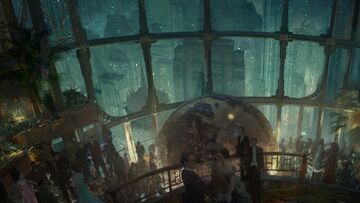
One of the first large-scale aquatic cities beneath the waters of Aziel
Humans have proven themselves to be adaptable to new environments countless times in history, colonizing the most uninhabitable of places. The oceans are no exception, as the abundance of water extensively complicated the construction of large-scale cities under the blue waves. Nonetheless, seven billion inhabitants live their daily lives within the waters of Aziel, whether in safer and shallower areas or in the deepest depths, where light never touches the seabed and alien creatures roam. The first aquatic cities can be traced back two centuries, when Nachor's Federation first started experimenting with the possibility of inhabiting the seas.
Shallower waters are substantially more desired areas of residence than deep sea in terms of underwater settlement, since light can penetrate the water effortlessly, offering breathtaking views of the seas and associated local vegetation wildlife. Most shallow water cities are intricate collections of resort domes, entertainment complexes, facilities and habitation complexes. Shallow seas are considered an effective environment to inhabit, most of Aziel's shallow waters have already been inhabited or are in the process of being occupied. Five billion people presently reside in shallow water cities, and this figure is expected to climb exponentially in the next decades.
Deep sea cities prevail as well, with structures comparable to those found in shallow water yet significantly stronger to withstand the great pressures of deep sea environments. Since shallow water cities are several times more spectacular and awe-inspiring, these deep sea cities are not a popular location to reside. Deep sea cities have only recently gained appeal, as they were previously regarded to be excessively expensive and complicated to construct in a fashion that would attract residents. Nonetheless, artificial environments have emerged around cities that provide abundant light, a phenomenon that deep sea animals were previously unaware of. Algae would soon begin to grow on the windows of deep marine habitats, however this problem was swiftly solved by developing artificial microbiological organisms that consume away at the algae. Marine snow obstructing the windows was also a problem at first, but it was resolved in the same way as the previous issue.
There are several construction regulations for all aquatic habitats, regardless of who constructed them or what they are utilized for. To begin with, all aquatic habitats must include sealed chambers where residents may seek refuge in the event of a flood. Furthermore, they must be either connected to other aquatic ecosystems by underwater railway networks or have an operational submarine. The former technique is used by all public aquatic communities, as they are all united by a refined system of undersea railroads below the seabed. Each train is also linked to a large public aquatic facility, which in turn is linked to a departure station on the land, providing for quick departure from an aquatic habitat.
In the seas of Aziel, aquatic arcologies, sometimes called as seascrapers, are a prevalent kind of habitat. Aquatic arcologies are only found in the ocean's deepest depths, reaching many kilometers beyond the sea level. The population of seascrapers can range from ten thousand to a million people, while the average population is estimated to be about two hundred thousand. Many seascrapers are as intricate as entire cities, yet they are all housed in one structure. Supersonic vacuum-lifts, which can carry any human from the bottom to the upper layer in less than a minute, are used to swiftly traverse through aquatic arcologies. Seascrapers, like aquatic cities, are connected to one another and to aquatic cities by maritime railway networks. Aquatic arcologies are made up of numerous layers, each of which serves a distinct function, such as residence, leisure, or business.
Orbital[]
Industry[]
History[]
Prehistory[]
The planet of Aziel formed in the planetary accretion disk of the star Altum, which was 1.2 light-years from Auralumina at that time. As it formed, the planet was a hot hell world completely covered in massive fields of molten lava and magma. As the worlds battled for a place in the Altum System, Aziel got kicked out after getting with with an ancient planet named "Tealium", blasted the planet out of the system, and left it slowly leaving the system. In that time, Aziel had big rings left over from the large collision.
Thousands of years after being kicked out of it's original home system of Altum, Aziel was a dark rogue planet destined to be left floating in outer space until the end of space and time. Luckily a nearby system called Auralumina was in the direction of Aziel's trajectory, catching the lonely world
Evolution of Life[]
Initial Colonization[]
Aziel was one of the first worlds to be colonized by the United *Terran Federation, shortly after the foundation of the nation. Aziel's colonization was part of Project Hyperion, a colonization effort which included colonization of seven additional worlds and was also humanity's first interstellar colonization endeavor in the Palioxis Starfield. Aziel's colonization would be the most pricey of all the worlds, given it was so far away from Theras and the other seven worlds that had yet to be colonized. Because Force Drives weren't as efficient back then, transit times would be several years.

Ryker in orbit around Aziel
On 97,305 CE, the colony ships Ryker, Saragossa, Spartacus, and Manticore emerged in a stable orbit around Aziel after five years of constant travel. The first colonies developed after only a few hours of surveying for suitable colonization regions, albeit they were primitive and soon breached by hostile fauna or destroyed by natural elements, as most of these colonies were built in severely perilous sections of the planet. Ryker's Landing, which was the largest settlement and was established on the placid meadows of Equis, would be the only one to remain, though it, like all the others beforehand, would soon be doomed.
By scale, overall living conditions, and safety, Ryker's Landing would quickly outrank all prior colonies, as well as the new ones that would be built shortly afterward. Nonetheless, it had one major flaw: a wide opening to Hollow Aziel around ten meters below the entire settlement. No one knew about the Hollow Aziel at the time, but they were worried that the ground might collapse and drag the structure down with it. People from Ryker's Landing would henceforth be relocated to other settlements across the world, as a sinkhole may collapse the settlement at any time. This sad tragedy occurred only two days after the evacuation, thereby bringing the settlement's short life to an end.
Urbanization of Aziel[]
The Great Separation[]
Modern Era[]
Orbital Constructs[]
Byzantos Ringworld[]
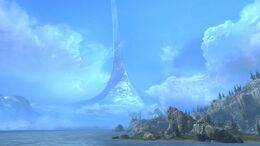
The Byzantos Ringworld is the most prominent and notable structure orbiting the world of Aziel, serving as a massive population center and tourism area, with the markets of commerce and industry going to great lengths since its construction.
The environment of the Byzantos Ringworld is very similar to that of Aziel, as it was originally intended for Humans to inhabit. However, as intergalactic tourism started getting popular in Cosmoria, the Byzantos Ringworld has been repurposed into many sections, with dense jungles and grasslands being scattered about its' surface. Since then, the use of advanced climate control systems and biotechnology have allowed most major species to live in the Byzantos Ringworld with no issues.
Major Moons[]
Cadonia[]

Cadonia is the biggest major moon orbiting Aziel, and the closest. Cadonia was once a rocky moon with no atmosphere and devoid of any life, but since it's terraformation in 56520 CE it has become a lush tropical world modeled after the more peaceful tropical areas of Aziel. Many species of both flora and fauna have been imported directly from Aziel to Cadonia, including Sand Darts and Sailphin. Cadonia's populace of ten billion inhabitants lives in various cities scattered around it's endless forests and plains. Artificial gravity generators have been placed everywhere on Cadonia, to make it more survivable. Cadonia also contains a small subsurface ocean, which was devoid of any life before the introduction of various highly adaptable deep sea species like Caerulaen Spinefish and Caerulaen Ghostrays.
Borealtum[]

Borealtum is the farthest major moon of Aziel. Borealtum itself is a captured moon from the outer Auralumina System. This factor, also combined with a high albedo means that the frigid moon is completely engulfed by water-ice and snow. Borealtum, even though it is seemingly not fit for habitation, the temperatures are very much survivable, and even has a breathable atmosphere with the pressure on the surface being 0.87 Atm. These properties, and of course liquid water which is present in small lakes frozen on top, which are frequent on the moon have given rise to an ecosystem of live thriving across the moon. From eight-legged arachnids to canine snow beasts, there's no shortage of life.
As such, Borealtum was the second moon of Aziel to be colonized, and it's population of a hundred billion rivals even some of the biggest colony worlds. Most of the massive populace lives in the deep subsurface oceans of Borealtum, with all of the deep-sea habitats having almost instantaneous elevators to the surface. The deep-sea population also doesn't have to worry about deep sea monsters, as the most advanced species of fauna are currently microbes, which do not present a threat at all. While not so rich in population, the cities on the surface of Borealtum offer a spectacular view of Aziel and it's many moons.
Messoria[]

Messoria is the third and last major moon of Aziel, and is as of currently considered the most inhabitable one. While it has an atmosphere perfectly suitable for carbon-based life, and even oceans of liquid water, frequently Messoria is obscured for days by massive ravaging sandstorms often covering the sky and not allowing any light to penetrate through the atmosphere onto the surface. This is the main factor as to why there is nearly no plant life on the surface. The larger bodies of water like oceans and seas aren't affected by the sandstorms, and as a result they are filled with life in some parts.
Even with these dangerous factors, many cities are constructed on Messoria, all domed by massive shields. In total the moon has an estimated population of ten billion. However when first set foot on in the year of 87,052 CE, it was originally planned to be a mining colony. Once, Messoria suffered from a war ten years after settlement which is now known as the Battle of Messoria, which engulfed the moon in total warfare for political reasons. After the war which lasted four years finally ended in pecie, Messoria became a major hub of trade, along with a high amount of technology being imported to Aziel and other worlds.
Minor Moons(TBD)[]
Erazium[]
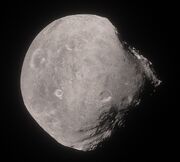
Erazium is the first natural satellite of Aziel, and the biggest with a diameter of forty five kilometers
Kyrlis[]

Kyrlis is the fourth natural satellite of orbiting beyond Messoria, and the second dwarf moon. Much alike the other dwarf moon of Secrenium, Kyrlis was formed when a massive asteroid collided with the major moon of Cadonia. It is a larger than average asteroid comprised primary of rocks, with trace amounts of iron, with a diameter of fifty kilometers. Kyrlis has a small mining station bolted to the moon, extracting precious resources. In three thousand five hundred years the entire small moon is estimated to be entirely mined.
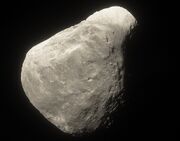
Secrenium[]
Overview[]
Aziel is covered by 4 continents, 2 oceans, and many small islands. Every continent is filled with different environments, ranging from hot savannah's to cold taiga's. Each continent, ocean, and island is filled with unique, and verdant life, from giant lizards, to tiny fish.
Continent[]
Equis[]
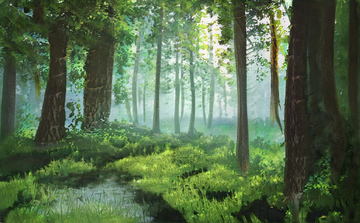
A lush forest on Equis.
Equis is the second most temperate of Aziel's four continents, with massive bioluminescent forests dominating the majority of the landscape, and vast deserts in between. The aforementioned bioluminescent forest contains many wonderous species of plants, including various species of glowing bushes, grass, and vines that make up the a large part of the ecosystem. The largest part of it's ecosystem however would be it's fauna which dominates the continent. From ravaging beasts, to peaceful herd species, there's no shortage of life on Equis.
Equis is the most populated out of all the four continents of Aziel, as it's the safest with no great dangers. It's population is very large, even being larger then entire colony worlds. One of the main factors for Equis having such a high population would be it's geography, as the terrain is mostly made out of endless expanses of vast grasslands and sparse woodlands.
The continent's major exports are more organic in nature compared to the other continents, as very few factories or refineries are on the surface. Thus, things like drinkable water and food are the continent's largest exports. The reason for this would be the large amount of freshwater on the continent's surface, with its thirty six large lakes of fresh drinkable water, which many species also depend on to survive and thrive. While in the food department, the Aenpari rainforests and jungles are teeming with flora and fauna of countless varieties, as well as endless expanses of fertile soil to grow and raise the needed food supply.
In the uppermost area of Equis lies Calen Taiga, where plant life is made more common and animal life rarer. It is one of the only areas on Equis where the ability of bioluminescence has not spread to. In the western area of this enormous taiga is the Taiga of Ruins, which originally was a lush part of the taiga, however it was entirely burnt down in a massive wildfire caused by yet unknown reasons.
A line of deserts runs through the continent of Aziel, which is itself called The Three Deserts. The desert located in the west is called the Euclian Desert" the middle is called the Eyanis Desert, and the eastern one is called the Nix Deser". These vast dunes share a single ecosystem of flora and fauna. Slicing the deserts are two massive forests called Aclush Woodlands, which hold an ecosystem similar to the one in the deserts-.
Located in the center of Equis, the Seupra Forests make up around half of the continent. In these forests many bioluminescent species of trees make up most of the ecosystem, while fauna is primarily herbivorous, gently feasting on the glowing plants. An unique lightshow is constantly going on during the night, where the grass creates stellar bioluminescent waves of light.
A small savanna-like area called Rhean Savanna exists near the equator bordering the Sea of Diversity. Many species of small flora flourish there, along with the creatures to consume them.
Aenpari[]
Adeon[]
Eloris[]
Islands[]
Eyus Island[]
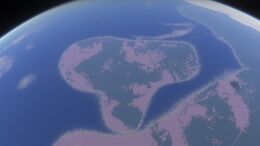
Eyus Island is a massive island in the shape of the head of an hammer, next to the Equis continent. It is made out of deserts, and plains. The fauna and flora of Eyus Island is almost the same as it is on Equis, however some new species appear on this island.
It is colonized with massive ecological city on it, called "City of Eyus", which has a small underground section of it. The island's terrain is mainly flat, including the deserts and plains. The island is an oasis of life, as it hosts a really high amount of flora, and fauna in the plains. Most of the fauna is herbivorous.
The deserts have host no life except some rare cacti. The island is connected to the continent of Equis by a massive highway. The island also has many factories on it. As it is an industrialized island
Lakes[]
Lake Rockspire[]
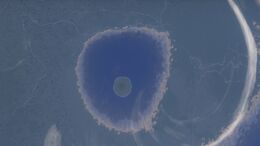
The Lake Rockspire is a massive lake on the continent of Aenpari, with the diameter of over a hundred kilometers. The average lake depth however is only forty meters. The lake has numerous spires made out of rock on the seabed, hence its name.
The island also has a massive dormant volcano in the middle of it. The lake is home to several exclusive fauna and flora species, including the Feloars.
Lake Cormaige[]
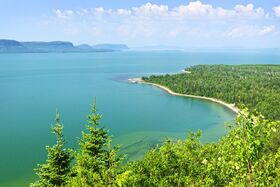
The Lake Cormaige is by far the deepest lake ever found on Aziel. It is located in the southern area of the Equis continent. While only around ten kilometers in lenght, the Lake Cormaige is the deepest, with the lowest part of it being approximately two kilometers below the sea level, essentially making it a rift lake. Lake Cormaige is the largest freshwater lake by volume on Aziel, containing 22 to 23% of the Aziel's fresh surface water. The depths of Lake Cormaige hide many deep-sea species, including the prominent Caerulaen Ghostrays.
Roaming the idyllic grasslands of Aziel are various species of mammals, some of which even being evolved to become semi-sentient, most commonly under a social hierarchy. While not as abundant as mammals, large avians are often seen soaring the skies, most often seen hunting aquatic creatures in the water below.
Aziel is often known for it's aquatic ecosystem of fauna, with apex predators like Irridalli seen sailing the tropical seas, or the majestic and highly intelligent Krayens are seen preying on smaller fish. The deep sea of Aziel is an unique environment, without any sunlight, life has evolved far differently that in the shallower areas. Bioluminescence is a common trait in these deep parts. Most life is gliding through the sea motionlessly, only moving when escaping or attacking, as energy is rare and precious at these depths.
The plant organisms on this world are made up of trees and flowers, with only a few dozen of grass species, even less bush species and almost no brush and fungi species. Although the grass species are few in number, they grow fast and cover wide areas. The trees and flowers cover a lot more though and because they use up most of the nutrients, other species like shrubs and fungi haven't been able to reach higher numbers.
The wonders seen on the surface are also seen underwater. A huge variety of corals and aquatic plants have made their home in the waters of this world, both living in harmony with each other, at least in most cases. Some species have developed into more aggressive forms, effectively trying to force their species wherever there's water for them. This has lead to the decline of some other species, but also to the rise of new, specialized predators.
Mammal Fauna[]
Reptilian Fauna[]
Avian Fauna[]
Arthropod Fauna[]
Invertebrate Fauna[]
Aquatic Mammal Fauna[]
Irridalli: Overview[]
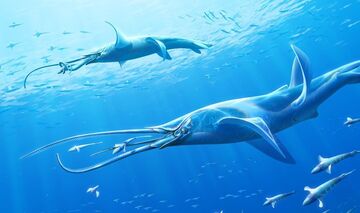
The Irridalli are a successful species of large-sized mammalian apex predators stalking the upper levels of the seas of Aziel, that prefer to live in tropical waters. Irridalli are aggressive carnivorous beasts feared by many, and the biggest recorded species on Aziel that exclusively reside in shallower waters, and as such, this species has been designated leviathan class. Irridalli have been imported from Thetis to Aziel.
Irridalli: Physical[]
Like many large creatures residing on Thetis, evolution has optimized their four-sided body plan into a sleek, secondarily bilaterally symmetrical shape able to move swiftly and efficiently through the ocean, with their a pair of frontal and posterior wings, covered in a fairly thick layer of translucent gelatinous matter. In addition, they have two minor fins on their rear side.
Irridalli possess two elongated jaws on the lower and upper mouth, with both of them being lethally barbed designed to swiftly kill it's prey. They also have an inner tentacle, that swiftly rolls around it's prey. A pair of eyes exist on Irridalli, with the ability to see more on the electromagnetic spectrum than an average Human.
Irridalli: Behavior[]
Possessing some social intelligence, Irridalli travel in loose pods to locate swarms of suitable food, at which time they separate and attempt to drive the prey nearer the surface, thus rendering them easier to capture. Despite this initial co-operation, the actual hunt itself is performed independently of the other pod members, cooperation only resuming when prey needs to be driven towards the surface once again.
Irridalli typically swim at about 10 km an hour while they are feeding and traveling, but can accelerate to more than 25 km an hour for short bursts. They are among the loudest animals on Aziel, emitting a series of pulses, groans, and moans, and it is thought that in the right oceanographic conditions, sounds emitted by Irridalli can be heard by other Irridalli up to 2,500 km away. Scientists think they use these vocalizations to communicate and along with their excellent hearing, perhaps to sonar-navigate the dark ocean depths in which they sometimes plunge to, feasting off of various species of deep sea creatures.
While Irridalli are quite fast, many prey species are considerably faster and swimming speed is not their primary weapon: Moving in behind prey, the large eyes fix on a target and when in range two tentacles launch outwards as an elongated and lethally barbed lower jaw attempts to impale it. If the strike is successful, the tentacles rapidly coil around the doomed creature and draw it towards the mouth.
Irridalli: Reproduction[]
Irridalli reach sexual maturity between the age of 15 and 20. They are dioecious and undergo sexual reproduction. Normally, they migrate near the equator to reproduce. Irridalli undergo a very elaborate mating ritual. The male and female spend time rolling around each other, then they take a deep dive into the ocean abyss as they continue to communicate with each other.
Irridalli reproduce via sexual meiosis. The male and female each produce haploid gametes. Male gametes are sperm, and the female gametes are eggs. A single sperm and egg fertilize to form a diploid zygote. They fertilize internally, meaning sperm is deposited inside the female.
Since Irridalli are placental mammals, the fetus develops inside of the mother in the uterus. The Irridalli fetus grows quickly at 2.50 cm per day after 3 months of gestation, and by the seventh month it stretches to 3.5 m in length. The calf is born tail first after a 12 month pregnancy, and it weighs 1,224 kg. Birth occurs primarily in the colder seasons. When born the calf immediately swims to the surface for oxygen. The mother watches over the young calf for a year, feeding it up to 90 kg of milk per day.
Salatrian: Overview[]
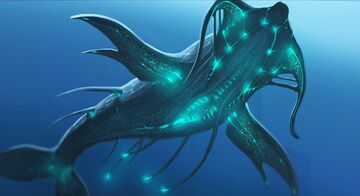
Salatrian is an aquatic mammalian species native to the lush and temperate life-filled world of Kataria, but have been imported to Aziel. They are pretty much known for their bioluminescent and large appearance, making them one of the largest species of Aziel.
Salatrian: Physical[]
The Salatrians are known for having a sleek body of two main fins, many minor fins and a lot of tentacles of around twenty five meters in size, and weighing seventy to one hundred forty kilograms in total, essentially making Salatrians the second biggest shallow-water species, rivaling the apex predators of Irridalli.
Salatrians are also noted for having a high amount of bioluminescent organs, mostly acting as glands dropping from their tentacles, however various other bioluminescent areas have been noted, especially on it's stomach, which itself is effectively 'cut' open, having a filter that is able to effectively filter various species of planktons out of the water into feeding tubes leading into it's internal digestive system. Salatrians have an abnormally smaller than average stomach, and are able to process food way faster than other species on it's homeworld.
Salatrians are able to see through their two pairs of large eyes, the reason for evolving so many eyes is likely to detect predatory organisms in their habitats. A large mouth also exists at the end of their head, but it is used for scaring off predatory species with a loud echo rather than consuming food.
Salatrian: Behavior[]
Despite their large size, Salatrians are one of the most peaceful species on Aziel, gradually swimming at slow speeds in colder waters which they prefer, however some Salatrians prefer to glide in tropical waters. There are so many in fact, that an entire subspecies called "Tropical Salatrian" was categorized by marine biologists.
Salatrians are highly social, and oftentimes swim in groups of ten to twenty individuals, oftentimes related to each other in some way. However sometimes Salatrians are excluded from their group, leaving them to find a new group in which they are accepted to. Salatrians operate under a social hierachy, and the leader of the group is usually the alpha Salatrian.
The Salatrians are also exceedingly intelligent, even going as far as having a single shared language, called Salatrianese by many others composed of changing the hue of their bioluminescent organs, and rarely even color in times of distress. Most communication happens between the individuals of a group, while sometimes they emit loud echoes to communicate with other groups across the world.
Salatrian: Reproduction[]
Between the ages of 15 and 20, most Salatrians attain sexual maturity. They are dioecious and reproduce sexually. To breed, they usually travel towards the poles. Salatrians have a complicated and not fully understood mating ceremony. The male and female spend time rolling around in circles, then take a deep dive into the ocean abyss while communicating with one another.
Sexual meiosis is used by Salatrians to reproduce. Hemiploid gametes are produced by both the male and female. Female gametes are eggs, while male gametes are sperm. A diploid zygote is formed when a single sperm and egg fertilize. Internal fertilization occurs when sperm is deposited within the female.
The fetus develops within the mother's uterus since Salatrians are placental animals. After three months of gestation, the Salatrian fetus grows at a fast rate, reaching a length of 5 meters by the seventh month. After a twelve month pregnancy, the newborn is delivered head first and weighs 1,224 kg. The newborn Salatrians swims to the surface for oxygen as soon as it is born. For over two years, the mother looks after the young calf, feeding it up to 120 kg of milk each day.
Birlen: Overview[]
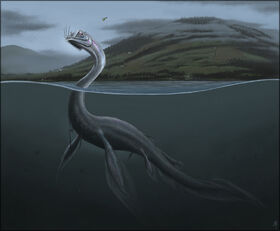
Birlen are a species of carnivorous marine mammals native to many freshwater lakes across the surface of Aziel. They are physically the largest freshwater species on Aziel. This has led to them being feared by many locals. Despite this initial fear, only two hundred specimen of this species have been discovered, indicating that this species may be near extinction.
Birlen: Physical[]
Birlen have a large body of around fifteen meters in lenght on average, thought some specimen exceeding this initial length have been discovered. An example is a Birlen discovered residing in Lake Cormaige, that was thirty meters in size.
The average body plan of Birlen is fairly simple, consisting of a main body greatly resembling an average eel. This body makes up only around thirty five percent of the creatures total length. The neck itself is a large part of the body, taking up thirty percent of the total length of a Birlen. The tail of a Birlen is as a little bit shorter than it's neck, and is covered in a layer of translucent matter.
Birlen have two pairs of fins on either side of their long body, which allows the Birlen to catch up with even the fastest creatures on Aziel. Like their tail, the fins of Birlen are covered in a thin layer of translucent matter. These help the Birlen to increase speed in the waters. Strangely, the Birlen possess two pairs of insectoid limbs at the beginning of their long neck. They serve no purpose, and are very likely left over from when they needed them.
Birlen see through their single pair of eyes mounted on their face which resembles that of a fish. These allow the Birlen to see very far, and can very easily spot a fairly large creature moving at a great distance. These eyes are what made Birlen so effective predators. Birlen also possess five elongated and lethal teeth, seen extruding from their lower jaw. These teeth are able to penetrate through essentially all of the creatures that the Birlen can encounter.
Birlen: Behavior (WIP)[]
Birlen are most of the time just regular peaceful mammals. Their many fins have optimized it's speed, allowing an average-sized Birlen to travel up to thirty two kilometers per hour. While rare occurrences, Birlen can greatly increase their speed, nearly doubling it for a short amount of time. These short bursts in speed are usually only used when in threat, or when the prey is too fast for the Birlen.
Birlen: Reproduction (WIP)[]
Aquatic Reptile Fauna[]
Zefariet: Overview[]
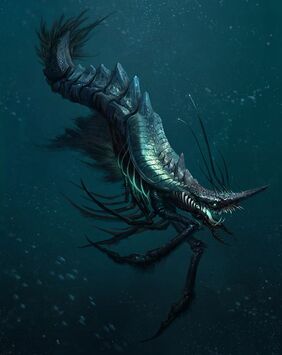
Zefariets are a rare species of marine reptiles found dominating the shallow waters of Poseidon's Lair, swiftly attacking any species it sees. As such, they are considered one of the most dangerous species on Aziel. Thought, they are so rare it is considered exceptionally lucky to see one in it's natural habitat.
Zefariet: Physical[]
Zefariets have a rather bulky and predatorial appearance, holding a very crustacean body and many large claws. Other appendages have been noted to aid in the development of locomotion underwater. The Zefareit also have large laws which appear to detach in order to take in a massive amount of prey. Other Zefariets are a lot more toned down and streamlined for aquatic travel, as evolution usually takes its course for them. Others have known to have their biological chemistry morph so severely that they are able to feed on unicellular organisms. This is accomplished through filter feeding of such organisms, though this is noted to be very rare through Zefariets.
The Zefariets also hold a notoriously tough skin and network of bones, which make them hard to kill. They also hold regenerative properties, which allow them to regrow limbs and other bodily sections.
Most Zefariets are characterized by their bioluminescent hues, which allow them to intimidate other lifeforms, or to see in certain abyssal situations. While it does take up a lot of energy, it is still easily accomplished. Other Zefariets have evolved to save their energy for other climates, attuning to them over millions of years.
Zefariet: Behavior[]
Zefariets are extremely hostile, typically attacking smaller aquatic organisms. The Zefariets have also been noted to be very social, hunting in packs and having a small system of community. However, many Zefariets are known to go rogue, hunting by themselves. Others have known to cannibalize, but this is obscenely rare in terms of the Zefariets.
Zefariets, when not hunting, glide the shallower waters of Poseidon's Lair at speeds of around fifty kilometers per hour, however, can trigger short bursts of speed essentially doubling their speed for a limited amount of time.
Sometimes, Zefariets are found travelling to the deeper areas of Poseidon's Lair, especially when they can not find any prey in their primary area of habitation. Most of Zefariets meet their death in the deeper areas, as extremely dangerous species like the Segrine are more common there.
Zefariet: Reproduction (TBD)[]
Zefariet have one of the strangest ways of reproducing known on Aziel. When reaching sexual maturity at around twenty to twenty five years of age. Male Zefariets give birth to tiny parasite-like organisms. Then on, these organisms glide in the waters until they find a suitable female. After a suitable female is located, the parasite-like organisms fuse with the body of the female, essentially using themselves to fertilize the eggs of a female.
When the eggs are fertilized around twenty times at average, the female moves to deeper waters and spawns. Typically female spawn around a thousand eggs in a year. These eggs have less than one percent chance of surviving. When an egg hatches, it has an equal chance to be either a female or a male.
Usually a newborn Zefariet moves to a tiny pack of other newborn Zefariets. This pack helps against the more dangerous predators of Poseidon's Lair and also helps them hunt. Usually a newborn Zefariet is around ten centimeters in length. However, when obtaining nutrients, it can fully mature in the short time of around a year.
Fish Fauna[]
Sand Dart: Overview[]
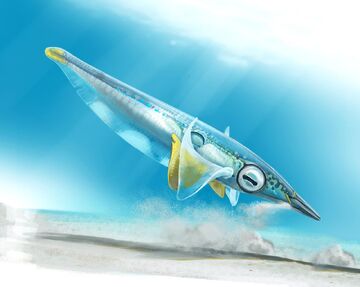
Sand Dart is a species of large marine fish exclusively residing in hot, sunny tropical waters native to the temperate world of Aziel. They make up an important part of the aquatic ecosystem, as they are the primary species controlling the population of aquatic crustaceans and such.
Sand Dart: Physical[]
The body plan of an average Sand Dart is effective for gaining a high amount of speed, and escaping ferocious predators of the sea. Over half the body of an average Sand Dart is translucent, helping them hide near the seabed. Some translucent parts include their fins, and their lower body. Sand Darts have two pairs of fins, one translucent and one yellow, necessary for high-speed travel.
Sand Dart: Behavior[]
Sand Darts slowly glide across the shallow tropical oceans in which they prefer to live, close to the seabed to avoid any contact with larger species like the Irridalli.
Sand Darts have a rich omnivorous diet, consisting of all sorts of aquatic crustaceans, while they can also consume aquatic flora, mostly in the form of kelp and seaweed. For a yet unknown reason, males typically tend to eat the plants while females eat the animals.
To escape from the predators, Sand Darts have evolved to learn to use their environment to their advantage, and often many Sand Darts are seen swiftly releasing an excessive amount of sand through their nostrils, to either distract nearby predators, or give themselves a slight boost in speed, but that rarely happens.
Sand Dart: Reproduction[]
The female Sand Dart scatter their eggs in the water among the plants and then the males fertilize the eggs. This is called external fertilization because the male waits to fertilize the eggs until they are outside of the female's body. The eggs stick to whatever they fall on and begin to develop. A typical female may produce up to 300,000 eggs, while some individuals may produce one million eggs over the breeding season. Larger females can generally produce more eggs. Depending on the water temperature, eggs take three or four days to hatch.
Aquatic Arthropod Fauna[]
Aquatic Invertebrate Fauna[]
Crystalline Cloakmouth: Overview[]
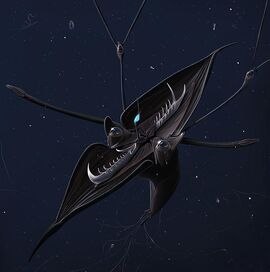
Crystalline Cloakmouth are a species of invertebrate predatory fauna inhabiting the lower depths of Aziel around the mesopelagic zone of the ocean. Sit and wait predation is an energy efficient way to hunt in the deep sea, and the Crystalline Crystalline Cloakmouth represents an extreme adaptation to this way of life.
Crystalline Cloakmouth: Physical[]
Crystalline Cloakmouth are highly sexually dimorphic, with males being no more than tiny parasitic organisms, while females being the Crystalline Cloakmouths oftentimes seen. Below is the physical description of a female Crystalline Cloakmouth.
Their reduced, soft body hangs below the highly modified mouthparts, which are dominated by huge vertical jaws. Sharp semitransparent mandibles are poised ready to snap shut on any prey lured inwards by the bioluminescent tip of the tongue. Prey that comes too close is skewered by the mandibles and then enclosed by the heavily pigmented jaws. This prevents they preys' defensive bioluminescence being detected by larger foes.
The two huge lower eyes are oriented upwards and modified to detect the bioluminescence of prey, or their shadows' against the downwelling surface light. The horizontal jaws, thin and elongated, are spread to the sides and covered in a line of fluid filled spheres able to detect vibrations in the water, a system also present around the rim of the main jaws. The horizontal mandibles are shorter and more robust than the crystalline seizing jaws, and are hidden away until prey is captured, which they proceed to butcher and then pass downwards into the pharynx.
The upper eyestalks are highly elongated and the post-ocular sections bifurcated into sensors adapted to detect the sex pheromones of conspecifics. Currents are so slow and the environment so vast that highly sensitive antennae are needed to detect minute concentrations of chemicals in the water. The small eyes on these tentacles are still functional but of low resolution; they monitor the light from the surface world and allow the Crystalline Crystalline Cloakmouth to tell night from day.
Crystalline Cloakmouth: Behavior[]
Crystalline Coalmouths are highly specialized predatorial species, oftentimes seen luring various deep sea species toward them through their bioluminescent organ. When prey gets too close, the Crystalline Cloakmouth ferociously closes it's jaw, leaving the prey to be trapped inside and digested alive.
Although ungainly, the Crystalline Crystalline Cloakmouth can move quickly in short bursts to escape predators. Defense consists of several stages: First, the jaws with their large surface area are clamped rapidly together, shooting the creature away in the opposite direction. At the same time, thin translucent threads are extruded from modified limbs near the tail to form a mesh in the fleeing animals' wake. Predators caught in this are tangled by the sticky threads, which bioluminescence on contact and thus render the predator visible to its own enemies. Proteins on the Crystalline Cloakmouths skin inhibit this reaction when it becomes entangled in its own threads. As a final defense, the Crystalline Crystalline Cloakmouth leaves the area using paired fins usually held tightly against its body, swimming slowly backwards to new hunting grounds.
Crystalline Cloakmouth: Reproduction[]
Crystalling Cloakmouth have a rather interesting way of reproduction. Usually a Crystalline Cloakmouth achieves sexual maturity in around 25 years. Typically a female attracts a male through repeatedly blinking it's bioluminescent light. The tiny male then essentially fuses with the body of the female, fertilizing it's eggs, then being eaten by the female for nutrients. A female usually mates with five males before spawning around one thousand eggs, half of which have no potential to give birth to a Crystalline Cloakmouth. After around two days, the eggs hatch, and tiny Crystalline Cloakmouths come out. Usually most are males, while females are rarer.
Civilizations[]
The Harbingers[]
The Harbingers were an ancient civilization that resided in the Aurum Pocket a little over two million years ago Only a little is known about them, since only damaged ruins of their civilization exist. They are theorized by being humanoid, and adapted to live in tougher environments. They also worshipped a mysterious being. They regularly sacrificed themselves to this mysterious being, as they believed it would lead them to a higher plane of existence. Nothing else is known about the mysterious being.
The Recturrents[]
The Recturrents were an ancient humanoid semi aquatic species found all over the shorelines, and oceans of Aziel. They could live on land, however preferred to live underwater. The species went extinct over a billion years ago, however some of their ruins still exist for mysterious reasons. They were highly religious, and worshipped a species of aquatic eel, which was god to them.
Translated from their language, their god resembled a massive eel, with green glowing eyes, and many sets of teeth. The god was named "Xeal", which is now an extinct species. The Recturrents could dive to the depths of over five kilometers underwater, and withstand the pressure. The exact appearance of the species is unknown, but it is theorized that they had tentacles from their face, and had four hands.
Hollow Aziel[]
Hollow Aziel is a massive subterranean ecosystem located approximately 450 kilometers below the surface of Aziel, and 5km in length. It is one of the strangest ecosystems in Cosmoria. The fauna and flora has grown to gigantic sizes, as they feed off the intense radiation from the core of Aziel. Hollow Aziel even has clouds, and someone might not even notice any difference between the surface, and Hollow Aziel.
Until very recently, no entrances of Hollow Aziel have been discovered. A sealed off long artificial tunnel of around 500km in length was discovered in 99,942 CE in the Aurum Pocket.
Strange Flora[]
Solar Sphere Plant[]
Solar Sphere Plants are the only reliable source of light in Hollow Aziel. Solar Sphere Plants are plants that grow exclusively on the ceiling of Hollow Aziel, and produce bioluminescence strong enough to light up a whole area in the radius of 1km. They are scattered rarely, to give almost the same amount of light to every single corner of Hollow Aziel. They tend to look like big stars in the sky when there aren't any clouds.
Tree Flora[]
Titanum-Bloss Trees[]
Titanum-Bloss Trees are a species of massive trees growing in the 'jungles' of Hollow Aziel. They are some of the strangest species of trees, as they are as hard as steel, and make for a reliable building material. Their roots are often tens of kilometers long, collecting nutrients from deep below Hollow Aziel. Once every year, they grow strange red bioluminescent fruits eaten by some herbivorous local fauna. At average, a Titanum-Bloss Tree has thousands of leaves, each of which are often over a meter long. The average size of these trees is around a hundred meters, however they can grow shorter in more colder climates.
